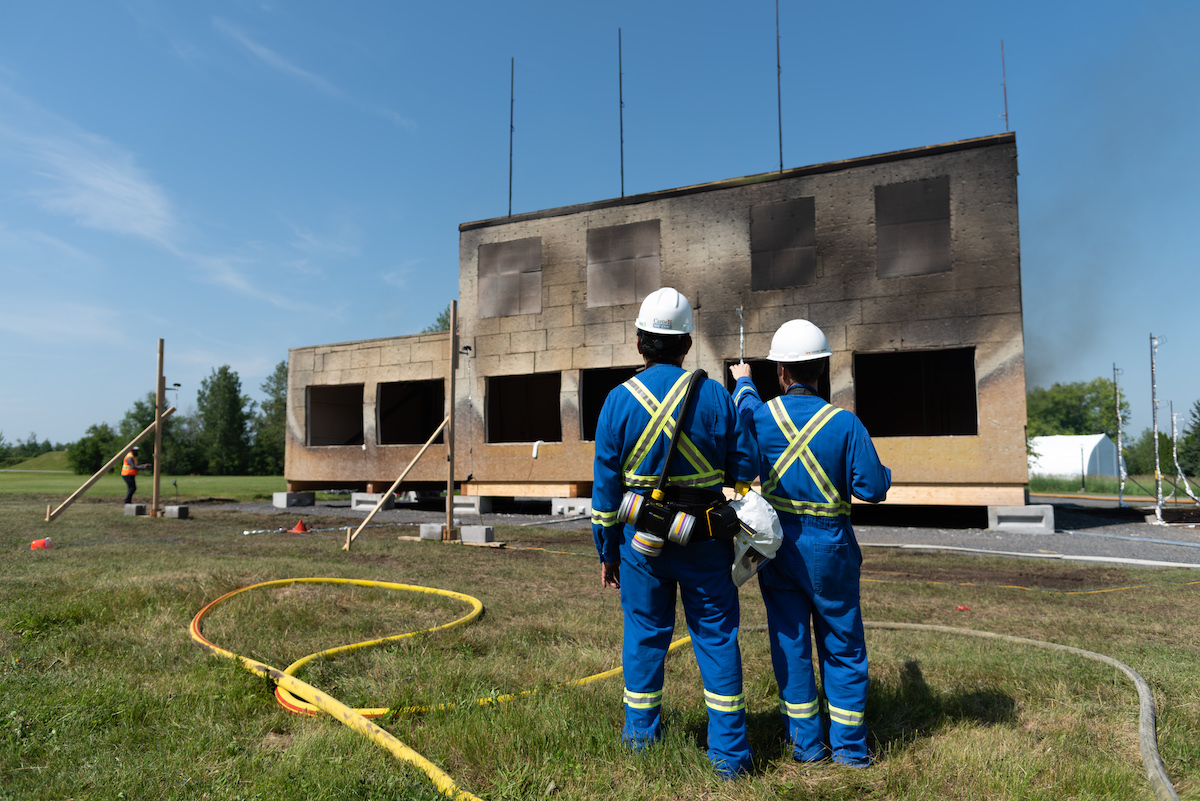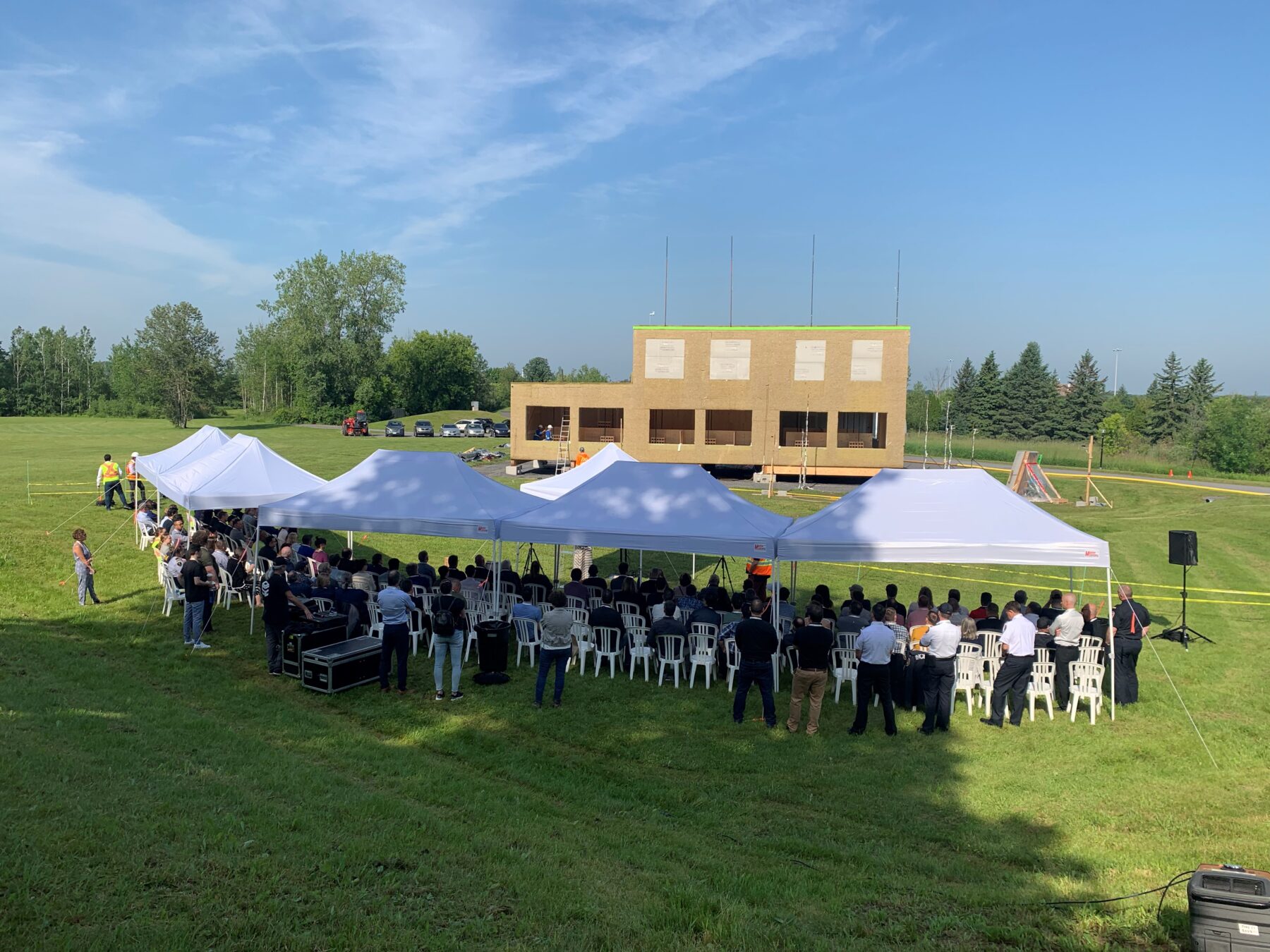Historic testing suggests mass timber performs well in fires
Experts tested mass timber products in five different fire scenarios, including offices, construction sites and residences.

Crews conduct mass timber fire testing. – Mark Cooper, courtesy CWC
Key Takeaways:
- It was the largest, most comprehensive mass timber fire testing in Canadian history.
- The study suggests, even in the most severe instances, taller mass timber structures can provide a level of fire performance that is on par with similar concrete and steel-constructed buildings.
- The testing was observed by more than 150 experts from across Canada.
The Whole Story:
Canadian researchers have been investigating mass timber fire performance in the nation’s largest and most comprehensive testing to date.
Their report shows engineered wood products, such as cross-laminated timber, offer good fire performance comparable to non-combustible materials.
Dubbed The Mass Timber Demonstration Fire Test Program, the national study looked at five scenarios using a two-storey, 334 square-metre mass timber structure.
Researchers say this makes it the nation’s largest and most comprehensive mass timber fire research ever. The study suggests, even in the most severe instances, taller mass timber structures can provide a level of fire performance that is on par with similar concrete and steel-constructed buildings.
“This new series of fire testing shows that taller wood buildings, including those with exposed timber, do achieve fire safety standards and provide good fire performance comparable to other building materials. They provide strong evidence to evolve the National Building Code,” said Marc Alam, senior manager, codes and Standards for Canadian Wood Council.
The testing was observed by more than 150 experts from across Canada. Fire officials, building regulators, insurance industry representatives, engineers, and architects, as well as wood industry professionals and National Research Council of Canada (NRC) fire research experts, witnessed the fire testing firsthand.
“These tests are giving municipalities, code officials, fire services and insurers a lot of good information — and it was really helpful that many of these folks were able to see the tests as they were conducted,” said Steven Craft a fire engineering expert and founding principal at CHM Fire Consultants Ltd., one of the firms contributing to the fire test design and analysis. “It is becoming clearer through this research that mass timber buildings can perform well and it isn’t going to be any more difficult to put out a fire in these buildings than in a steel or a concrete building, when built to best practice standards.”

Testing scenarios included a fully furnished residential suite as a baseline, exposed mass timber in an occupied residence, fire at a construction site, a more severe construction site fire and fire in an occupied office made of mass timber.
Officials say that in all five tests, the test mass timber structure allowed for full burn out of the fire, whether the scenario was during construction or for a finished structure, in the rare event of no fire sprinkler activation or fire service intervention, and the stairwell was not adversely affected in any test. The tests concluded in the summer of 2022 and the report written by NRC was recently released.
“Through all the [mass timber] fire research that we’ve done to date, and over the last 15 years, I believe the experts have a very good appreciation for how we can design mass timber buildings to be safe and fire resistant. And these tests are showing how to go taller and expose more wood in these buildings while staying fire-safe,” said Craft.
Researchers noted that test results also show how open plan workplaces with exposed mass timber —an increasingly popular trend in office design—can be fire safe.
“In the open office floor plan test, the fire quickly died down on its own, showing that once the fuel load is consumed by the fire—basically the furnishings—the fire decays,” said Craft. “As follow-ups to past tests with smaller compartments, this new research shows we get as good or better performance in an open office scenario.”
The project team noted that the testing could benefit B.C.’s efforts to be a global leader in mass timber.
“I anticipate the province, and the broader industry in B.C., will benefit from this comprehensive fire testing as the information obtained continues to streamline the building code, helping us tackle climate change and boost the construction of more sustainable, affordable housing”, said Keyes.
The research initiative was supported by the NRC, Canadian Wood Council, and federal and provincial governments.
The Canadian Wood Council will be giving a presentation that highlights the fire tests and results on November 16 in Vancouver as part of the inaugural WoodWorks Summit. To register or learn more go to woodworkssummit.ca.

